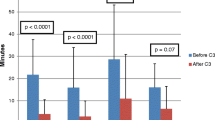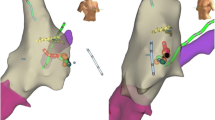Abstract
Purpose
Catheter ablation is performed under fluoroscopic guidance. Reduction of radiation dose for patients and staff is emphasized by current recommendations. Previous studies have shown that lower operator experience leads to increased radiation dose. On the other hand, less experienced operators may depend even more on fluoroscopic guidance. Our study aimed to evaluate feasibility and efficacy of a non-fluoroscopic approach in different training levels.
Methods
From January 2017, a near-zero fluoroscopy approach was established in two centers. Four operators (beginner, 1st year fellow, 2nd year fellow, expert) were instructed to perform the complete procedure with the use of a 3-D mapping system without fluoroscopy. A historical cohort that underwent procedures with fluoroscopy use served as control group. Dose area product (DPA), procedure duration, acute procedural success, and complications were compared between the groups and for each operator.
Results
Procedures were performed in 157 patients. The first 100 patients underwent procedures with fluoroscopic guidance, the following 57 procedures were performed with the near-zero fluoroscopy approach. The results show a significant reduction in DPA for all operators immediately after implementation of the near-zero fluoroscopy protocol (control 637 ± 611 μGy/m2; beginner 44.1 ± 79.5 μGy/m2, p = 0.002; 1st year fellow 24.3 ± 46.4.5 μGy/m2, p = 0.001; 2nd year fellow 130.3 ± 233.3 μGy/m2, p = 0.003; expert 9.3 ± 37.4 μGy/m2, P < 0.001). Procedure duration, acute success, and complications were not significantly different between the groups.
Conclusion
Our results show a 90% reduction of DPA shortly after implementation of a near-zero fluoroscopy approach in interventional electrophysiology even in operators in training.

Similar content being viewed by others
References
Kim KP, Miller DL, Balter S, Kleinerman RA, Linet MS, Kwon D, et al. Occupational radiation doses to operators performing cardiac catheterization procedures. Health Phys. 2008;94:211–27.
Klein LW, Miller DL, Balter S, Laskey W, Haines D, Norbash A, et al. Occupational health hazards in the interventional laboratory: time for a safer environment. Heart Rhythm. 2009;6:439–44.
Yamagata K, Aldhoon B, Kautzner J. Reduction of fluoroscopy time and radiation dosage during catheter ablation for atrial fibrillation. Arrhythmia Electrophysiol Rev. 2016;5:144–9.
Heidbuchel H, Wittkampf FH, Vano E, Ernst S, Schilling R, Picano E, et al. Practical ways to reduce radiation dose for patients and staff during device implantations and electrophysiological procedures. Europace. 2014;16:946–64.
Razminia M, Willoughby MC, Demo H, Keshmiri H, Wang T, D'Silva OJ, et al. Fluoroless catheter ablation of cardiac arrhythmias: a 5-year experience. Pacing Clin Electrophysiol. 2017;40:425–33.
Sánchez JM, Yanics MA, Wilson P, Doshi A, Kurian T, Pieper S. Fluoroless catheter ablation in adults: a single center experience. J Interv Card Electrophysiol. 2016;45:199–207.
Casalla M, Russo AD, Pelargonio G, Del Greco M, Zingarini G, Piacenti M, et al. Near zero fluoroscopic exposure during catheter ablation of supravenTricular arrhYthmias: the NO-PARTY multicentre randomized trial. Europace. 2016;18:1565–72.
Giaccardi M, Del Rosso A, Guarnaccia V, Ballo P, Mascia G, Chiodi L, et al. Near-zero x-ray in arrhythmia ablation using a 3-dimensional electroanatomic mapping system: a multicenter experience. Heart Rhythm. 2016;13:150–6.
Kim KP, Miller DL. Minimising radiation exposure to physicians performing fluoroscopically guided cardiac catheterisation procedures: a review. Radiat Prot Dosim. 2009;133:227–33.
De Ponti R. Reduction of radiation exposure in catheter ablation of atrial brillation: lesson learned. World J Cardiol. 2015;7:442–8.
Zipes DP, Calkins H, Daubert JP, Ellenbogen KA, Field ME, Fisher JD, et al. 2015 ACC/AHA/HRS advanced training statement on clinical cardiac electrophysiology (a revision of the ACC/AHA 2006 update of the clinical competence statement on invasive electrophysiology studies, catheter ablation, and cardioversion). Heart Rhythm. 2016;13:e3-e37.
Kleemann T, Brachmann J, Lewalter T, Andresen D, Willems S, Spitzer SG, et al. Development of radiation exposure in patients undergoing pulmonary vein isolation in Germany between 2007 and 2014: great potential to minimize radiation dosage. Clin Res Cardiol. 2016 Oct;105(10):858–64.
Attanasio P, Schreiber T, Pieske B, Blaschke F, Boldt LH, Haverkamp W, et al. Pushing the limits: establishing an ultra-low framerate and antiscatter grid-less radiation protocol for left atrial ablations. Europace. 2017 Mar 4; https://doi.org/10.1093/europace/eux010.
Bourier F, Reents T, Ammar-Busch S, Buiatti A, Kottmaier M, Semmler V, et al. Evaluation of a new very low dose imaging protocol: feasibility and impact on Xray dose levels in electrophysiology procedures. Europace. 2016;18:1406–10.
Huo Y, Christoph M, Forkmann M, Pohl M, Mayer J, Salmas J, et al. Reduction of radiation exposure during atrial fibrillation ablation using a novel fluoroscopy image integrated 3-dimensional electroanatomic mapping system: a prospective, randomized, single-blind, and controlled study. Heart Rhythm. 2015;12(9):1945–55.
Vañó E, Rosenstein M, Liniecki J, Rehani MM, Martin CJ, Vetter RJ. ICRP publication 113. Education and training in radiological protection for diagnostic and interventional procedures. Ann ICRP. 2009;39(5):7–68.
Mercuri M, Mehta S, Xie C, Valettas N, Velianou JL, Natarajan MK. Radial artery access as a predictor of increased radiation exposure during a diagnostic cardiac catheterization procedure. J Am Coll Cardiol Intv. 2011;4:347–52.
Author information
Authors and Affiliations
Corresponding author
Ethics declarations
Conflict of interest
The authors declare that they have no conflict of interest.
Ethical approval
All procedures performed in studies involving human participants were in accordance with the ethical standards of the institutional and research committee and with the 1964 Helsinki declaration and its later amendments. For this type of study, formal consent is not required.
Rights and permissions
About this article
Cite this article
Wannagat, S., Loehr, L., Lask, S. et al. Implementation of a near-zero fluoroscopy approach in interventional electrophysiology: impact of operator experience. J Interv Card Electrophysiol 51, 215–220 (2018). https://doi.org/10.1007/s10840-018-0333-3
Received:
Accepted:
Published:
Issue Date:
DOI: https://doi.org/10.1007/s10840-018-0333-3




